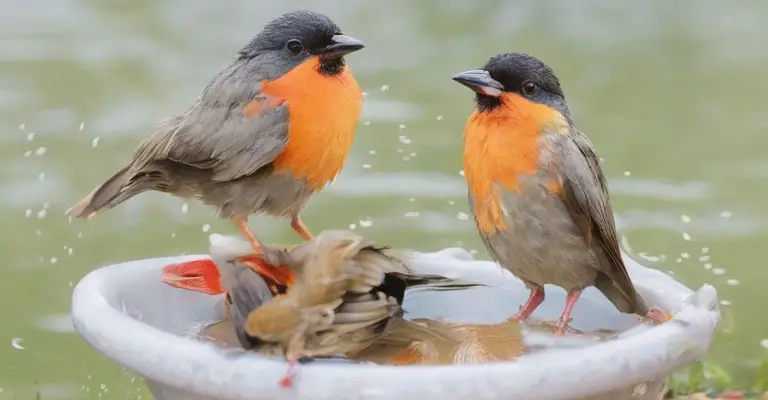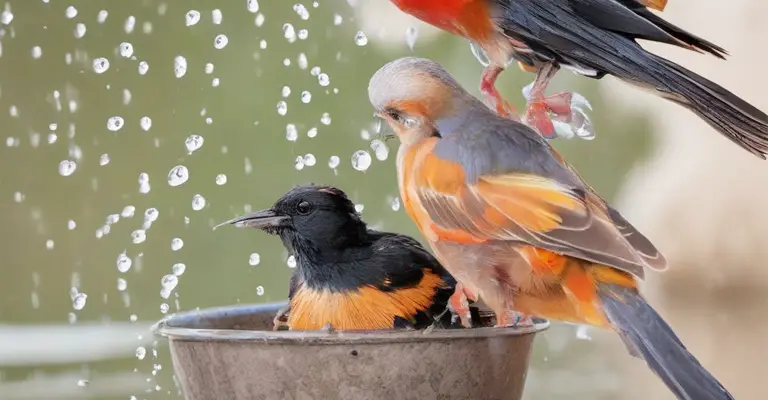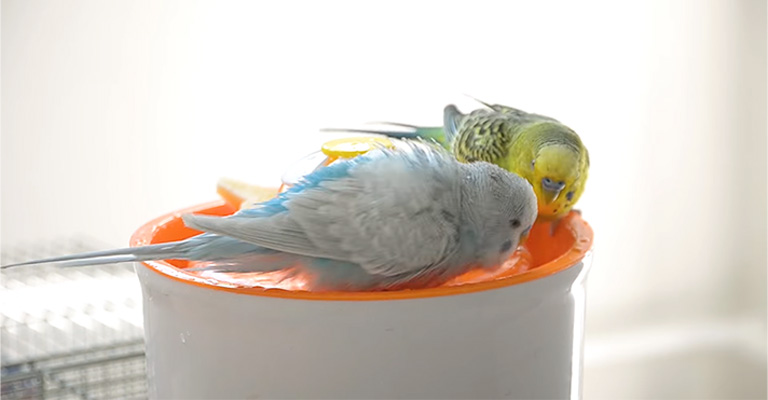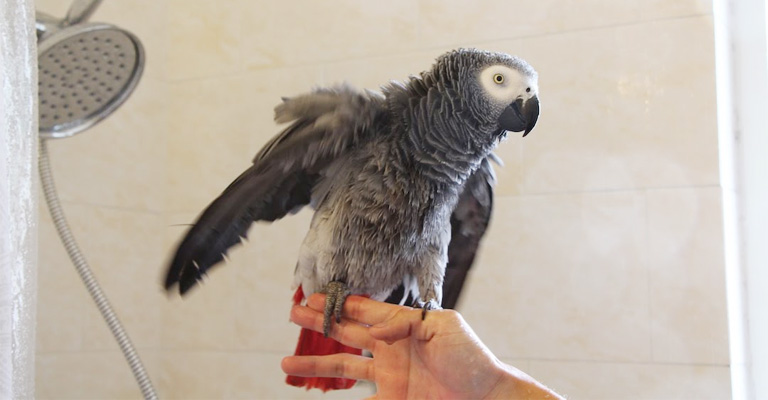Bathing is not only a refreshing ritual for humans but also an essential part of caring for our avian companions. Properly bathing your pet bird can help maintain their health, hygiene, and overall well-being.
However, determining when and how to bathe your feathered friend can be a bit perplexing, as it varies from species to species.
In this blog post, we will delve into the crucial aspects of bathing pet birds, exploring the ideal timing and methods to ensure your bird enjoys a clean and comfortable experience.
From selecting the right bathing technique to considering your bird’s preferences, we’ll provide you with comprehensive insights into creating a bathing routine that suits both you and your pet.
Whether you have a chirpy budgie or an elegant cockatoo, this guide will help you make bath time a delightful and beneficial activity for your feathered companion.

When Should I Bath My Pet Bird?
Bathing your pet bird is an important aspect of their care routine, contributing to their overall health and well-being. However, the frequency and timing of baths can vary depending on the species of bird and individual preferences.
Here are some general guidelines to help you determine when to bathe your pet bird:
Species-Specific Needs
Different bird species have varying requirements when it comes to bathing. Some birds, like budgies and cockatiels, enjoy frequent baths and may benefit from a daily or weekly shower.
Others, such as African Greys or Amazons, may prefer less frequent baths, perhaps every few weeks. Research your bird’s specific species to understand its natural bathing habits and preferences.
Environmental Factors
Consider the climate and humidity in your location. Birds in arid environments might require more frequent baths to prevent their skin and feathers from drying out. On the other hand, birds in more humid regions may need fewer baths.
Monitor your bird’s plumage and skin condition to determine if it’s time for a bath. Dry or flaky skin can indicate the need for more frequent bathing, while overly wet or soiled feathers might suggest less frequent baths.
Observation and Behavior
Pay attention to your bird’s behavior and cues. Many birds will signal their desire for a bath by fluffing their feathers, dipping their heads into their water dish, or displaying excitement when they see running water.
Some may prefer mist baths from a spray bottle, while others may enjoy bathing in a shallow dish. Learn to recognize your bird’s preferences and adjust the bathing schedule accordingly.
The timing of when to bathe your pet bird depends on its species, environmental conditions, and individual preferences.
Regular observation and understanding of your bird’s signals will help you establish an appropriate bathing routine to keep your feathered friend clean and content.
Always use lukewarm water and avoid harsh chemicals when providing baths to ensure the health and happiness of your pet bird.
How Often Should I Bath My Pet Bird?

The frequency of bathing your pet bird depends on several factors, including the species of the bird, environmental conditions, and the bird’s individual preferences. Here are some general guidelines:
Species-Specific Needs
Different bird species have varying bathing preferences. Some birds enjoy and benefit from frequent baths, while others may prefer less frequent bathing. Research your specific bird species to understand its natural bathing habits.
For example, small parrots like budgies and cockatiels often enjoy more frequent baths, while larger parrots like African Greys or Amazons may prefer less frequent bathing.
Climate and Humidity
Consider the climate and humidity in your location. Birds in drier climates or during dry seasons may require more frequent baths to prevent their skin and feathers from drying out.
Conversely, birds in more humid environments may need fewer baths. Monitor your bird’s condition, especially its feathers and skin, to determine if it needs more or less frequent bathing.
Observation and Behavior
Pay attention to your bird’s behavior and cues. Birds often indicate their desire for a bath by fluffing their feathers, dipping their heads into their water dish, or displaying excitement when they see running water.
Some birds may enjoy a daily misting or spraying with lukewarm water, while others might prefer a deeper, shallow dish for a full-body soak.
Individual Preferences
Each bird is unique, and their preferences can vary. Some birds may love bathing and want to do it frequently, while others may be more reserved about it. It’s important to observe your bird’s reactions and adjust the bathing schedule to match their comfort level.
There is no one-size-fits-all answer to how often you should bathe your pet bird. It’s essential to consider your bird’s species, local climate, and individual preferences.
Regular observation and responsiveness to your bird’s cues will help you determine the ideal bathing frequency to keep your feathered friend clean and healthy. Always use lukewarm water and ensure the bathing experience is gentle and enjoyable for your bird.
Preparing for the Bathing Session

Preparing for a bathing session for your pet bird is crucial to ensure their comfort, safety, and enjoyment. Here are steps to help you get ready for a successful bathing session:
Choose the Right Time
Pick a time when your bird is most active and alert. Many birds enjoy bathing in the morning when they are naturally more active. Avoid bathing them during their rest or sleep hours.
Select a Suitable Container
Depending on your bird’s preferences, you can use a shallow dish, a sink with a few inches of lukewarm water, or a spray bottle. Ensure the container is clean and free of any contaminants.
Use Lukewarm Water
The water temperature should be comfortably warm, similar to the temperature of your body. Test it with your hand to make sure it’s not too hot or too cold.
Choose the Right Location
Pick a quiet, calm area for the bathing session to minimize stress for your bird. Avoid drafty areas or places with strong airflow that might chill your bird when wet.
Gather Necessary Supplies
Have all the supplies you need within easy reach. This includes the bathing container, towels, a gentle bird-safe soap (if necessary), and any toys or treats you plan to use to encourage your bird to enjoy the experience.
Safety Precautions
Ensure that the bathing container is stable and won’t tip over. Never leave your bird unattended during the bathing session, especially if there’s water involved.
Create a Relaxing Atmosphere
Dim the lights or draw curtains if necessary to create a calming environment. Soft, soothing music or your bird’s favorite tunes can help relax them.
Offer Encouragement
Speak to your bird in a gentle and reassuring tone to let them know it’s bath time. Use positive reinforcement by offering treats or toys to associate bathing with a positive experience.
Observe Your Bird’s Comfort
Pay attention to your bird’s body language during the session. If they seem stressed or uncomfortable, stop the bathing session and try again later. Respect your bird’s preferences and boundaries.
Post-Bathing Care
After the bath, gently pat your bird dry with a clean, soft towel or let it air-dry in a warm, draft-free area. Ensure they are completely dry before returning them to their cage.
Remember that not all birds will enjoy bathing, and it may take time for some to get used to it. Be patient and persistent, and over time, your bird may come to appreciate and even look forward to their bathing sessions.
How to Bath a Pet Bird?

Bathing your pet bird is an essential part of their grooming and hygiene routine, and it can also be an enjoyable experience for both you and your feathered friend.
Here’s a step-by-step guide on how to bathe a pet bird:
Step 1: Gather Your Supplies
Before you start, ensure you have everything you need within arm’s reach:
- A clean, shallow container (like a bird bath, sink, or a plastic dish)
- Lukewarm water (the temperature should be comfortably warm, like a baby’s bath)
- Clean, soft towels
- A gentle bird-safe shampoo (if necessary, for certain species like cockatiels)
- Optional: a misting spray bottle
- Bird treats or toys for positive reinforcement
Step 2: Choose the Bathing Method
Determine the bathing method your bird prefers:
- Full Immersion: Some birds enjoy being placed in a shallow container with a few inches of lukewarm water. Ensure the water level is safe for your bird’s size, so they can comfortably sit or splash.
- Misting: Others prefer being misted with lukewarm water using a spray bottle. This method mimics natural rain and can be less intimidating for some birds.
- Shower: Some birds may enjoy bathing in the shower with you. Use a handheld showerhead or a gentle mist setting to provide a light shower experience.
Step 3: Prepare the Bathing Area
Choose a quiet, draft-free location for the bathing session. Close curtains or blinds to ensure privacy and minimize distractions. Make sure the room is comfortably warm, as birds can easily become chilled when wet.
Step 4: Introduce Your Bird to the Water
Place the bathing container or set up the misting spray bottle within your bird’s sight but at a comfortable distance. Allow your bird to observe the water source to reduce anxiety. You can even place some favorite toys near the bath to make it seem inviting.
Step 5: Start the Bath
If using the full immersion method, gently place your bird in the shallow container with the lukewarm water. Allow them to explore and splash at their own pace.
If misting, start by spraying a gentle mist over your bird’s plumage, focusing on the feathers on their back and wings. Ensure the water pressure isn’t too strong or frightening.
Step 6: Monitor Your Bird
Keep a close eye on your bird during the bath. Watch for signs of enjoyment, such as active splashing, ruffling feathers, and vocalizations.
However, be vigilant for signs of stress or discomfort, like excessive shivering, trying to escape, or aggression. If your bird seems uncomfortable, stop the bath immediately.
Step 7: Provide Positive Reinforcement
Offer treats or praise your bird with soothing words to associate the bathing experience with positive emotions. This helps your bird feel more comfortable and secure during future bathing sessions.
Step 8: Dry Your Bird
After the bath, gently pat your bird dry with a clean, soft towel. Avoid vigorous rubbing, as it can damage delicate feathers. Alternatively, you can let your bird air-dry in a warm, draft-free area. Ensure they are completely dry before returning them to their cage.
Step 9: Clean and Store Bathing Supplies
Thoroughly clean and dry the bathing container or spray bottle, as stagnant water can harbor bacteria. Store these items in a clean, dry place until the next bathing session.
Step 10: Be Patient and Consistent
Not all birds will take to bathing immediately, so be patient and persistent. Some birds may need time to get used to the idea. Consistency is key, so try to establish a regular bathing schedule that aligns with your bird’s preferences.
Each bird is unique, and their bathing preferences can vary widely. Pay attention to your pet bird’s cues and preferences to create a positive and enjoyable bathing experience for them.
Post-Bath Care and Drying
Post-bath care and proper drying are essential to ensure your pet bird remains healthy, comfortable, and free from any potential issues that can arise from being wet. Here’s a guide on how to provide post-bath care and ensure your bird is adequately dried:
1. Gently Towel Dry
After the bath, it’s important to gently pat your bird dry with a clean, soft towel. Avoid rubbing or wringing out the feathers, as this can damage them. Use the towel to absorb excess water by gently pressing it against your bird’s feathers. Pay particular attention to the feathers on their back, wings, and tail.
2. Avoid Hairdryers
Avoid using hairdryers or heat lamps to dry your bird. These devices can become too hot and easily burn your bird’s delicate skin or feathers. Natural air drying is the safest method.
3. Let Your Bird Air Dry
Allow your bird to air dry in a warm, draft-free area. Ensure the room temperature is comfortable for your bird. If your bird has access to sunlight, natural sunlight can also help with the drying process. Make sure the area is free from drafts, as birds can become chilled when wet.
4. Monitor Your Bird
During the drying process, keep an eye on your birds to ensure they’re comfortable and not showing signs of distress. Birds can shiver when they’re wet, which is a normal response to help generate heat and dry off.
However, if your bird appears excessively stressed, agitated, or shivering uncontrollably, it’s a sign that it may be too cold, and you should consider moving it to a warmer location.
5. Encourage Preening
After your bird is mostly dry, it will likely engage in preening behavior to rearrange and clean their feathers. This is a natural process and helps maintain feather health. Provide a clean and safe environment for preening.
6. Return to Cage
Once your bird is completely dry and comfortable, return them to their clean and dry cage. Ensure that their cage is also free from drafts and has dry bedding.
7. Clean Bathing Supplies
After the bath, remember to clean and dry the bathing container or spray bottle thoroughly to prevent the growth of harmful bacteria. Stagnant water can become a breeding ground for germs if not properly cleaned.
8. Establish a Routine
Consistency is key when it comes to bathing and drying. Try to establish a regular bathing schedule that aligns with your bird’s preferences and needs. Over time, your bird may become more comfortable with the process.
Post-bath care and drying are crucial to keep your pet bird healthy and comfortable. Always prioritize your bird’s well-being and ensure they are completely dry before returning them to their cage.
Avoid using heat sources like hairdryers, as they can be harmful, and instead rely on natural air drying in a warm, draft-free environment. With proper care, your bird will remain clean, happy, and healthy.
Factors to Consider While Bathing a Pet Bird
Bathing a pet bird requires careful consideration of various factors to ensure their safety, comfort, and well-being. Here are key factors to keep in mind:
- Species: Different bird species have varying bathing preferences and requirements. Research your bird’s species to understand its natural bathing habits. For example, some parrots may prefer full immersion baths, while others may prefer misting.
- Frequency: Determine how often your bird should be bathed based on its species, climate, and individual preferences. Some birds enjoy daily baths, while others may only need one once a week.
- Water Temperature: Use lukewarm water for the bath, similar to a baby’s bath. Ensure it’s not too hot or too cold, as extreme temperatures can stress or harm your bird.
- Bathing Method: Choose a bathing method that suits your bird’s preferences. This could be a shallow dish, a spray bottle for misting, or a gentle stream of water from a faucet or showerhead.
- Environment: Create a quiet, draft-free space for the bath to minimize stress. Ensure the room is comfortably warm to prevent your bird from becoming chilled when wet.
- Observation: Pay close attention to your bird’s body language and behavior during the bath. Look for signs of enjoyment, such as splashing and vocalization, as well as signs of stress, like excessive shivering or trying to escape.
- Positive Reinforcement: Use treats, soothing words, or favorite toys to create a positive association with bathing. Reward your bird for participating in the bath to make it a pleasant experience.
- Safety Measures: Ensure the bathing container is stable and won’t tip over. Never leave your bird unattended during the bath to prevent accidents.
- Drying: After the bath, gently towel-dry your bird or let them air dry in a warm, draft-free area. Avoid using hairdryers or heat lamps, as they can easily burn your bird’s delicate feathers.
- Cleaning: Clean and dry the bathing container or spray bottle thoroughly after each use to prevent bacterial growth. Stagnant water can become a breeding ground for germs.
- Routine: Establish a consistent bathing routine that aligns with your bird’s preferences. Over time, your bird may become more comfortable with the process.
- Individual Preferences: Every bird is unique, and their comfort level with bathing can vary. Respect your bird’s boundaries and preferences, and adjust the bathing routine accordingly.
- Health Considerations: If your bird has any health issues or injuries, consult with an avian veterinarian before bathing. Some medical conditions may require special care.
By considering these factors, you can provide a safe and enjoyable bathing experience for your pet bird, promoting their overall health and happiness.
FAQs
The timing and frequency of bird baths depend on the species, but generally, once a week is a good starting point. Some birds may prefer more frequent baths, while others less. Pay attention to your bird’s behavior and adjust accordingly.
There’s no one-size-fits-all method. Options include a shallow dish, misting with a spray bottle, or a gentle shower. Choose the method your bird is most comfortable with and monitor their response for enjoyment or stress.
Yes, you can use tap water, but ensure it’s at a lukewarm temperature to prevent shocking your bird. If your tap water contains chlorine or other chemicals, consider using filtered or dechlorinated water.
Generally, birds don’t require shampoos or soaps. Most birds maintain their feathers naturally. However, for some species like cockatiels, a gentle bird-safe shampoo may be used sparingly, following product instructions.
To make baths enjoyable, use positive reinforcement like treats or toys. Create a calming environment, be patient, and respect your bird’s preferences. Over time, your bird may become more comfortable with the bathing routine.
Wrapping Up
Bathing your pet bird is not just about keeping them clean; it’s an opportunity to strengthen your bond and enhance their quality of life. Understanding when and how to bathe your avian friend is a crucial step in their care routine.
By following the guidelines provided in this blog post, you can ensure your bird’s bathing experience is a source of joy and well-being, contributing to their vibrant plumage and overall health.
So, whether it’s a leisurely misting or a playful splash in a shallow dish, embrace bath time as a delightful ritual in your bird’s daily life, and watch them thrive in the comfort of their clean and happy feathers.
Have a nice day.